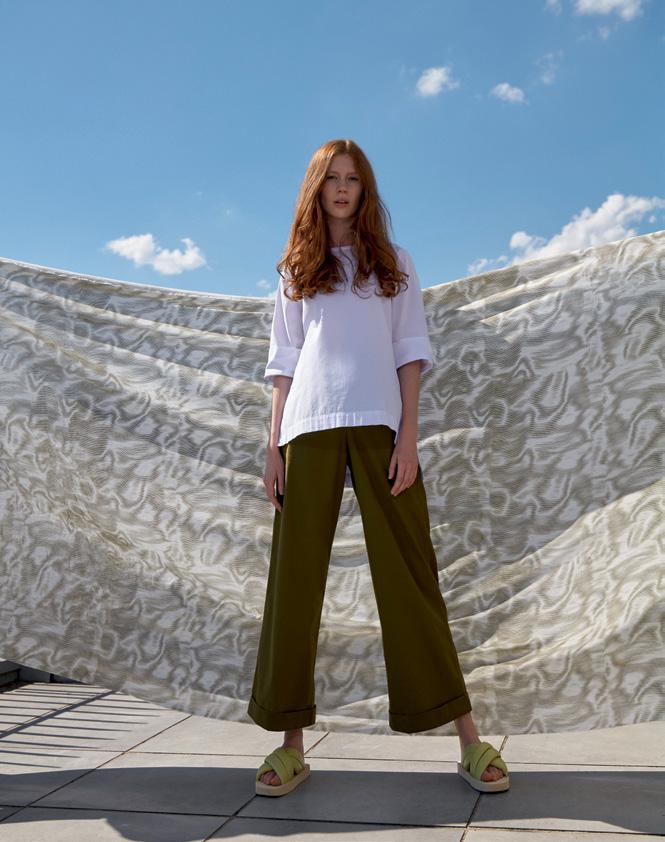
4 minute read
INTERVIEW
True sustainability or eco-fraud? Echt nachhaltig oder Öko-Täuschung?
Sustainability is en vogue, and trends promise profit - many brands try to get their pieceof the pie: Terms like “eco-friendly” and “environmentally friendly" are thrown around - but these are not protected and are often misleading. How do you tell the difference between real sustainability and greenwashing? We asked sustainability expert Uti Johne: She has been engaged in the topic for more than ten years and is a managing partner at "modem conclusa", a PR & communications agency for sustainable business.
Advertisement
MRS. JOHNE, WHAT DOES SUSTAINABILITY MEAN IN FASHION?
It's about complex interrelationships - when I buy an item, it has an impact across the globe: where does the raw material come from, who dyed the pants? It's about the interplay and balance between many factors along the supply chain. Precisely because the topic is so multifaceted, the UN launched the Sustainable
Development Goals (SDGs) in 2015. In total, 17 goals are intended to cover all aspects of the topic and serve as a guideline.
WHAT CAN CONSUMERS LOOK FOR WHEN SHOPPING?
Companies transparently communicating (tauschen: communicating transparently) is a good indicator. The more information a brand puts out there, the more trustworthy I rate it. Claims should be formulated precisely and confirmed with numbers.
Seals such as GOTS are a orientation help, but they are also expensive: small firms often can't afford them. Again, communication helps; it's a good sign when companies talk about their difficulties.
HOW DO I DISTINGUISH GREENWASHING FROM REAL SUSTAINABILITY?
Companies that engage in greenwashing use terms like 'environmentally friendly' or 'fair' in an inflationary way. From my experience, one can remember: the more blatantly such claims are put out into the world, the more caution is often called for. If you then try to look at more detailed information and notice that the communication remains vague and the production chain is not understandable, that is an alarm signal.
WHAT CAN I DO AFTER THE PURCHASE?
First and foremost: wash at low temperature and not too often; that protects the environment and the garments. Today's detergents are already very effective at 30 degrees. Clothing swap parties are fun and a great way to save items from the garbage can.
My tip: Try to think more in cycles. And: stay informed, and engage with the topic!
For more information on the SDGs, visit 17ziele.de
Nachhaltigkeit liegt im Trend und Trends versprechen Profit – klar, dass viele Marken auf den vermeintlichen Öko-Zug aufspringen: Es wird um sich geworfen mit Begriffen wie „ecofriendly“ und „umweltschonend“ – die sind aber nicht geschützt und daher oft irreführend. Wie also unterscheidet man echte Nachhaltigkeit von Greenwashing? Wir haben die sympathische NachhaltigkeitsExpertin Uti Johne gefragt: Sie beschäftigt sich seit über 10 Jahren mit dem Thema und ist geschäftsführende Gesellschafterin bei „modem conclusa“, einer PR- & Kommunikationsagentur für nachhaltiges Wirtschaften.
FRAU JOHNE, WAS BEDEUTET NACHHALTIGKEIT IN DER MODE?
Es geht um komplexe Zusammenhänge – wenn ich ein
Kleidungsstück kaufe, hat das Auswirkungen über den ganzen Globus: Wo kommt der Rohstoff her, wer hat die Hose gefärbt? Es geht um Zusammenspiel und
Ausgleich zwischen vielen Faktoren entlang der Wertschöpfungskette. Gerade, weil das Thema so vielseitig ist, hat die UN im Jahr 2015 die SDGs (Sustainable
Development Goals) ins Leben gerufen. Insgesamt 17 Nachhaltigkeitsziele sollen alle Aspekte des Themas abdecken und als Richtschnur dienen.
WORAUF KÖNNEN VERBRAUCHER BEIM SHOPPEN ACHTEN?
Transparente Kommunikation von Firmenseite ist ein guter Indikator. Je mehr Informationen ein Unternehmen öffentlich macht, umso vertrauenswürdiger würde ich es einschätzen. Claims sollten präzise formuliert sein und mit Zahlen bestätigt werden. Siegel wie GOTS helfen bei der Orientierung, sind aber teuer: Kleine Unternehmen können sie sich oft nicht leisten. Auch hier hilft Kommunikation, es ist ein gutes Zeichen, wenn Firmen über Schwierigkeiten reden.
WIE UNTERSCHEIDE ICH GREENWASHING VON ECHTER NACHHALTIGKEIT?
Unternehmen, die Greenwashing betreiben, verwenelemente-clemente.de
den Begriffe wie ,umweltfreundlich´ oder ,fair´ oft inflationär. Aus meiner Erfahrung heraus kann man sich merken: Je marktschreierischer solche Claims in die Welt getragen werden, desto mehr Vorsicht ist oft geboten. Versucht man dann, genauere Informationen einzusehen und merkt, dass die Kommunikation wage bleibt und die Produktionskette nicht wirklich nachvollziehbar ist, dann ist das ein Alarmsignal.
WAS KANN ICH NACH DEM KAUF TUN?
Vor allem: Nicht zu heiß und zu oft waschen, das schont Umwelt und Kleidungsstücke. Heutige
Waschmittel sind bereits ab 30 Grad sehr wirkungsstark. Kleidertauschpartys machen Spaß und sind eine tolle Möglichkeit, Klamotten vor der Tonne zu retten. Mein Tipp: Versuchen, mehr in Kreisläufen zu denken. Und: informiert bleiben, beschäftigt euch mit dem Thema!

Coat Monu and Pants Maki made of European linen Shirt Faly made of organic cotton-Popeline and Pants Rayla Sports made of European linen

Dress Kisa from recyceled material mix, Shirt Lito and Pants Skara made of European linen Shirt Vari and Pants Skara made of European linen



Shirt Bani und Pants Anasy made of organic cotton
Top Wadi and Pants Maki made of European linen
Dress Kaiu and Pants Sogo made of organic cotton-Popeline


Top Wadi and Pants Maki made of European linen

spring summer 2023








